How does the valve work in a washing machine?
 Almost all modern washing machines are equipped with solenoid valves. It is these devices that are responsible for drawing water into the tank, being an improved “faucet” - a shut-off device. But unlike an engine or pump, valve mechanisms are practically unfamiliar to machine users, which often leads to their breakdown. We suggest that you do not stand aside, but analyze the principle of operation of the washing machine valve, its structure and types. This will help you get to know the machine better and save money on equipment maintenance.
Almost all modern washing machines are equipped with solenoid valves. It is these devices that are responsible for drawing water into the tank, being an improved “faucet” - a shut-off device. But unlike an engine or pump, valve mechanisms are practically unfamiliar to machine users, which often leads to their breakdown. We suggest that you do not stand aside, but analyze the principle of operation of the washing machine valve, its structure and types. This will help you get to know the machine better and save money on equipment maintenance.
What is this device for?
Almost all modern washing machines, regardless of price segment and country of origin, are equipped with solenoid valves. These devices are sure to be found on budget models from Indesit with Ariston, and on expensive Samsung, Bosch and LG. The location and appearance of the valve mechanism may vary, but the function and operating principle remains the same.
The solenoid valve is an essential element of the filling system of a modern washing machine.
The main task of the inlet valve is to control the flow of water into the washing machine tank. In short, the device works as follows: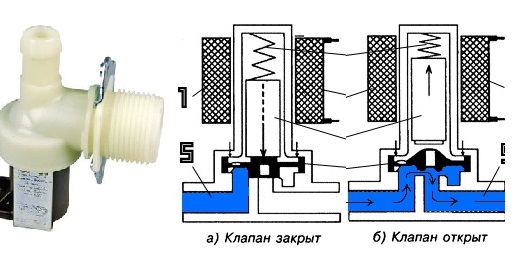
- the user starts the washing program;
- the board sends a command to the valve to draw water;
- the valve coil is activated, the membrane “opens”;
- water is taken from the water supply;
- the pressure switch controls the level of incoming water; as soon as the required volume is reached, it reports to the module;
- the board commands to stop the flood;
- the valve is activated, the membrane closes, and the flow of water stops.
In simple words, the valve acts as a shut-off valve in the washing machine - a tap. With its help, the collection of water into the tank begins or stops, through the inlet hose, dispenser and pipe system. The operation of the device is controlled by the control board.
Structural elements
Studying its design will help you understand in more detail how the valve works. This is a small device, white, blue or gray, located where the inlet hose connects to the washer. The device consists of the following parts:
- frame;
- electromagnetic coil with core;
- spring;
- a disk fixed on the core (plays the role of a valve that blocks the flow of water into the machine).
The intake valve body is made of high-temperature resistant polymer materials, as well as brass and stainless steel. The membrane and seals and gaskets that ensure tightness are made of heat-resistant rubber, rubber or silicone. The main role is played by electric magnets - solenoids installed in the retractor coil.
The simple design of the fill valve is constantly being improved by manufacturers. Trying to increase the service life of the device and speed up the collection of water, companies are experimenting with materials, coatings, shape and number of coils. But the function and operating principle of the valve mechanism remains unchanged.
How does the valve function?
The filling valve operates from the control board, changing the “open” position to the “closed” one. Most of the time the mechanism remains motionless - no voltage is applied to the coil, the disk is lowered down, the membrane and spring are pressed against the seat. All this ensures the tightness of the device, and water from the water supply does not enter the equipment.
As soon as the user starts the wash, the processor sends a corresponding signal to the valve coil. The electromagnets are activated, the rod is retracted along with the piston, the disk rises, opening the “entrance” into the machine. Pressurized water begins to flow into the tank.
Dialing stops after the next signal from the module. It receives information from the pressure switch about the end of the set and turns off the supply of electric current to the coil. The magnetic field weakens, the membrane is activated, the rod returns to its original position and the “flap” is lowered. The system detects a full tank and starts the cycle. And so on with every wash.
To operate the valve, a voltage of 220V and a clock frequency of 50 Hz are required.
Some valve models have their own characteristics. Thus, when operating outdated single-coil devices, the lever of a mechanical command apparatus is activated. With its help, water is drawn first into one compartment of the powder receiver, and then into the other. Modern valve mechanisms have from two to five coils, which simplifies filling the drum and increases the wear resistance of the device.
Types of devices
Water supply valves are found on almost every washing machine and operate on the same principle, but often differ in type and other characteristics. Typically, normally closed mechanisms are installed on machines that operate from the interaction of current and electric magnets. Devices vary according to several criteria: from sizes and materials to the number of coils.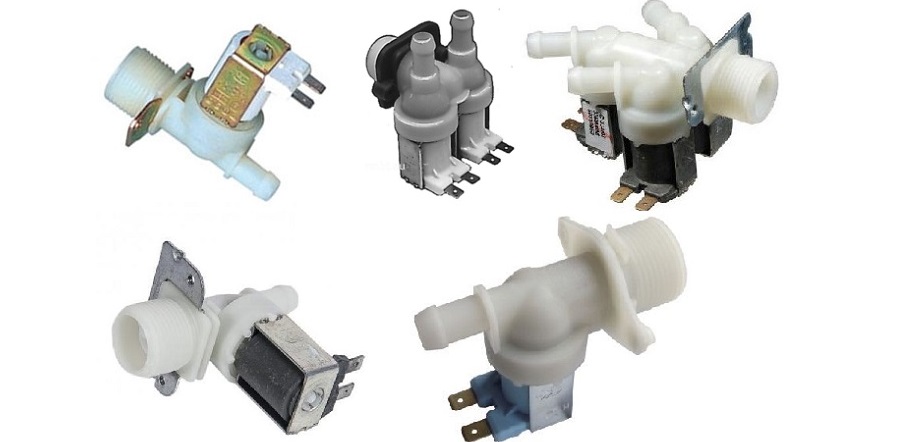
- Number of coils. “Old” machines were equipped with single-coil valves, while modern ones often have 2-3, and often 4 and 5 solenoids. The more magnets, the faster the device works and the more reliable the mechanism.
- Material of manufacture.The body can be plastic or metal, and the gaskets can be made of rubber, silicone, rubber or fluoroplastic.
- Size of water supply fittings. More often there are valves designed to connect to a ½ or ¾ inch hose.
There are universal valves marked 1/90. These devices have one outlet located at a right angle, while the fixing plate remains removable and can be easily adjusted to the desired degree. Due to its “portability”, the device is suitable for most single-reel machines.
Interesting:
Reader comments
- Share your opinion - leave a comment
Categories
Washing machine repair


For buyers

For users

Dishwasher


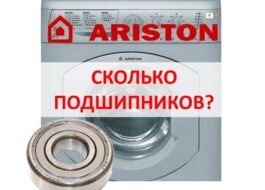
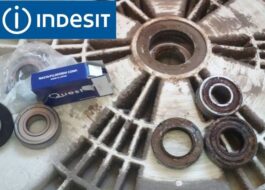

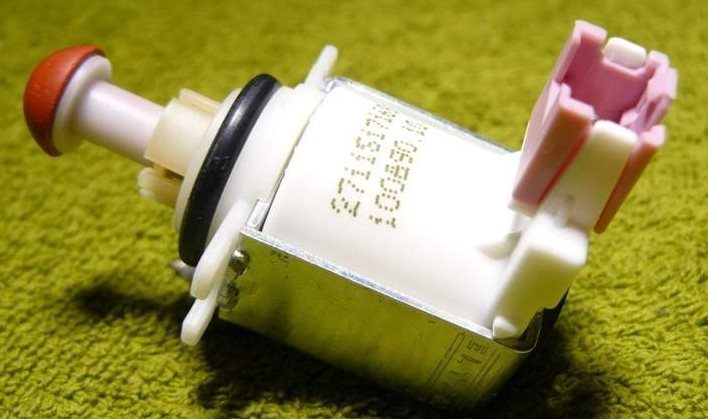
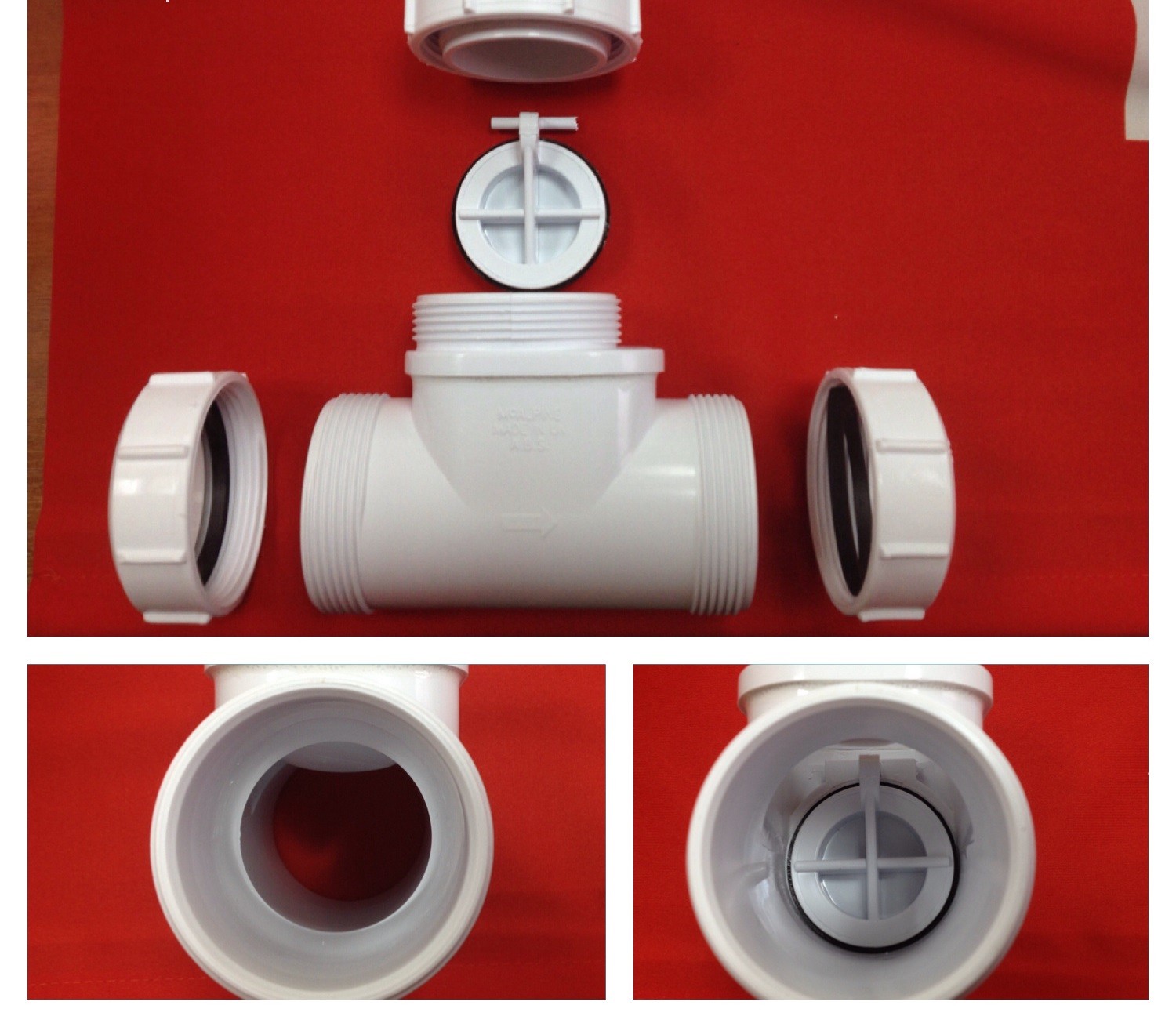










Add a comment